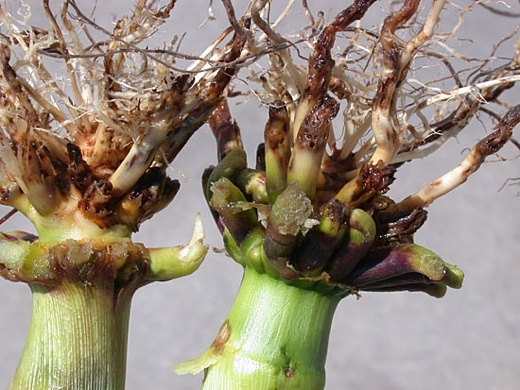By Jack Kaskey on 15 June 2012 for Bloomberg News -
(http://www.bloomberg.com/news/2012-06-15/monsanto-corn-injured-by-early-rootworm-feeding-in-illinois.html)

Image above: Monsanto GMO corn root pruning by worms immune to Bt pesticide. From (http://farmweeknow.com/story.aspx/corn-rootworm-damage-seen-western-il-0-60548).
Monsanto GMO corn has been overwhelmed in parts of Illinois by rootworms that hatched a month early, renewing concern that the bugs are becoming immune to the insecticide engineered into the crop.
An “amazing” number of rootworms have emerged as adult beetles, the earliest start in at least 30 years, Michael Gray, an entomologist at the University of Illinois at Urbana, said today in an online journal. The insects “severely pruned” the roots of corn observed June 7 at a farm in Cass County, about 200 miles (322 kilometers) southwest of Chicago.
The western corn rootworm is one of the most destructive pests and historically cost U.S. farmers about $1 billion a year in damages and chemical pesticides before crops with built-in insecticide were developed. Corn fields in four states were overrun with the bugs last year, incidents that the Environmental Protection Agency suspects is a sign of increasing resistance to the insecticide.
The damaged fields in Illinois have been planted with corn continuously for at least 10 years, including six consecutive years with corn engineered to produce the Cry3Bb1 protein from Bacillus thuringiensis, or Bt, a natural insecticide, Gray said.
“Under these conditions, the selection pressure for resistance development is markedly increased,” he said.
The damaged plants probably will fall over, a phenomenon known as lodging, as the insects continue to dine on the roots and the plants gain height, Gray said. The rootworm begins life as a root-chewing grub before developing into an adult beetle.
Monsanto evaluated fields on the Cass County farm and will collect bugs for study next week, said Danielle Stuart, a spokeswoman for the St. Louis-based company.
“This is a unique situation and there were surrounding fields that had little to no damage, so we also want to better understand why we see some fields more heavily infested than others,” she said an e-mail.
Growing Resistance
The Cry3Bb1 protein is engineered into Monsanto crops and SmartStax corn, which contains a second Bt protein from Dow Agroscience and DuPont/Pioneer. Monsanto, the world’s largest seed company, introduced its rootworm-killing corn technology in 2003. Less than 0.2 percent of the 37 million acres planted with the trait last year experienced unexpected rootworm damage, the company has said.
An Iowa State University study published last July was the first to confirm that some rootworms have evolved resistance to Monsanto’s Bt corn. A study to determine whether rootworms that damaged Illinois fields last year are resistant to the modified crop should be completed in August, Gray said.
Early Rootworms
Farmers should begin scouting for high rootworm populations earlier than usual in case insecticides need to be applied, Monsanto said.
“The combination of a mild winter, early spring planting, and the hot, dry conditions has created the potential for heavy insect pressure in corn fields this season,” Stuart said.
Monsanto’s worst resistance problem is with crops engineered to tolerate its Roundup herbicide. Weeds that Roundup no longer kills have invaded as many as 20 million acres (8.1 million hectares) of corn and soybeans, according to a Dow study.
As many as 28 million acres of cotton, soybean and corn may host Roundup-resistant weeds by 2015, according to Syngenta.
See also:
Ea O Ka Aina: Widespread failure of GMO pesticides 12/2/11
Ea O Ka Aine:Monsanto GMO Bt Corn Failing 9/2/11
.
No comments :
Post a Comment